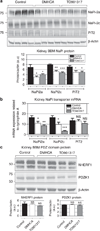Liver X receptor-activating ligands modulate renal and intestinal sodium-phosphate transporters
- PMID: 21677638
- PMCID: PMC3428205
- DOI: 10.1038/ki.2011.159
Liver X receptor-activating ligands modulate renal and intestinal sodium-phosphate transporters
Abstract
Cholesterol is pumped out of the cells in different tissues, including the vasculature, intestine, liver, and kidney, by the ATP-binding cassette transporters. Ligands that activate the liver X receptor (LXR) modulate this efflux. Here we determined the effects of LXR agonists on the regulation of phosphate transporters. Phosphate homeostasis is regulated by the coordinated action of the intestinal and renal sodium-phosphate (NaPi) transporters, and the loss of this regulation causes hyperphosphatemia. Mice treated with DMHCA or TO901317, two LXR agonists that prevent atherosclerosis in ApoE or LDLR knockout mice, significantly decreased the activity of intestinal and kidney proximal tubular brush border membrane sodium gradient-dependent phosphate uptake, decreased serum phosphate, and increased urine phosphate excretion. The effects of DMHCA were due to a significant decrease in the abundance of the intestinal and renal NaPi transport proteins. The same effect was also found in opossum kidney cells in culture after treatment with either agonist. There was increased nuclear expression of the endogenous LXR receptor, a reduction in NaPi4 protein abundance (the main type II NaPi transporter in the opossum cells), and a reduction in NaPi co-transport activity. Thus, LXR agonists modulate intestinal and renal NaPi transporters and, in turn, serum phosphate levels.
Figures







References
-
- Tonelli M, Pannu N, Manns B. Oral phosphate binders in patients with kidney failure. N Engl J Med. 2010;362:1312–1324. - PubMed
-
- Foley RN. Phosphate levels and cardiovascular disease in the general population. Clin J Am Soc Nephrol. 2009;4:1136–1139. - PubMed
-
- Chiu YW, Adler SG, Budoff MJ, et al. Coronary artery calcification and mortality in diabetic patients with proteinuria. Kidney Int. 2010;77:1107–1114. - PubMed
Publication types
MeSH terms
Substances
Grants and funding
LinkOut - more resources
Full Text Sources
Other Literature Sources
Miscellaneous

